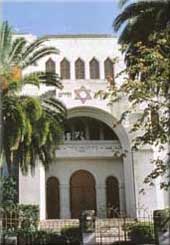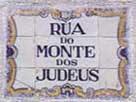Virtual Jewish World: Costa Verde, Portugal
The Costa Verde is a touristic and coastal region of northwest Portugal.
Porto
Viana de Castelo
Ponte de Lima
Amarante
Other Places of Interest
Porto
 |
The capital of Northern Portugal, Porto stands proudly above the river Douro because of its markedly commercial and bourgeois traditions, it was one of the major centers of attraction for Jewish traders, particularly during the middle ages. The earliest known Jewish quarter was built inside the old city wall, in what is now Rua de Santa Ana, close to Rua Escura and Largo do Colegio. it is still possible today to appreciate the medieval layout of these streets, not very far from the Cathedral, a masterpiece of Romanesque-Gothic architecture. Later, in 1386, Dom Joao I gave the Jews some land on which to build themselves a new quarter so that a small Jewish village was created in the streets which today surround the church of Nossa Senhora da Vitoria, between the Monastery of Sao Bento and Rua de Belmonte. The synagogue was situated on the Escadas da Vitoria, a set of steps which the local people still refer to as "Escadas da Esnoga" (the Steps of the Synagogue, a linguistic distortion of the correct word Sinagoga) and where there still remains a plaque with this name.
A little further to the north, in Passeio das Virtudes, was the Jewish Cemetery. Attention is also drawn in this area to the Latin inscription in the church of Sao Bento da Vitoria, which testifies to the memory of the old Jewish quarter. Moving southwards and passing by the Palacio da Bolsa (Stock Exchange) with its exotic Arab Room (decorated in the popular 19th-century revivalist style), it is worth paying a visit to the Ribeira (riverside district), where the centuries-old hustle and bustle of commerce takes place against the backdrop of the area’s medieval architecture and the unforgettable beauty oft he river, further enhanced by the barcos rabelos (the typical old boats used for transporting Port Wine). Here in the Ribeira and in Rua da Alfandega, in the heart of the historical center which UNESCO has classified as World Heritage, the Jews opened their warehouses and shops, side by side with one of the most beautiful churches in Porto (the Basilica of Sao Francisco, Gothic in origin, but with a Baroque interior, full of exuberant carved gilded woodwork). Almost opposite this church stands the Casa do Infante whose archaeological center and museum underline the importance of Infante Dom Henrique (Prince Henry the Navigator) as the mentor of the Portuguese Discoveries. The close relationship that existed between Prince Henry and certain illustrious Jews is well known, for the latter provided an important part of the commercial and financial backing that Portugal needed for such a momentous enterprise. The Jewish quarter of Monchique once stood in the Bairro de Miragaia to the north of Rita da Alfandega, next to the Convento de Monchique. One part of the former medieval town center that still Survives today is Rua do Monte dos Judeus, where, in 1826, one of the most important Hebraic inscriptions in Portugal was discovered: the Monchique stone, which is now exhibited at the Museu Arqueologico do Carmo, in Lisbon.
 Rua do Monte dos Judeus (The Street of the Jews’ Hill) |
To the west of the riverside area is the district known as Foz, with its promenade and elegant mansions built at the turn of the century. Returning to the center and to the north of Rua de Belmonte, there are many other points of interest to be found. Passing by the Torre dos Clerigos (a Baroque tower that is the very symbol of the city), the visitor comes to the Avenida dos Aliados, where the town hall is to be found, and off which run the lively shopping streets, such as Rua de Santo Antonio and Rua de Santa Catarina. In addition to the rich collection of decorative art exhibited at the Museu Nacional dos Reis, there are also some interesting collections of 19th and 20th-century Portuguese paintings and sculptures. In the area of Boavista, at No. 340 Rua Guerra Junqueiro, is the present-day synagogue, the Mekor Haim
(Fountain of Life), built in 1929 by the Jewish Community of Porto.
On the opposite bank of the river Douro, which offers the visitor a panoramic view of the city of Porto, it is difficult to resist the attractions of paying a visit to the Port Wine cellars, where you can also sample this unique wine.
Viana do Castelo
This city, 59 km north of Porto, famous both for its fine handicraft and colorful regional costumes, has as its backdrop the estuary of the river Lima. Such it setting obviously made a decisive contribution to its commercial and maritime vocation, and there were a large number of Jews amongst the merchants who devoted themselves to trading with Northern Europe, particularly at English and Flemish ports. In 1442, the city’s proctors requested Dom Afonso V to establish clear boundaries for the Jewish quarter. This quarter was situated in what is now the city’s historical center, around the present-day Praca da Republica, where the old Town Hall now stands (built in a Gothic style, like the beautiful parish church), together with the Casa da Misericordia (the Charity Hospital, built in the Mannerist style and containing a rich collection of’ sacred art). Other impressive buildings are the 16th-century Convento de Santana and the Municipal Museum (with its interesting collection of Indo-Portuguese furniture).
Ponte de Lima
This ancient town in the valley of the river Lima, famous for its Roman bridge, medieval towers, and beautiful manor houses (which are open to tourists wishing to stay there in private accommodation), also had its own Jewish quarter in the 14th and 15 th centuries, whose inhabitants were the main organizers of the local fair. Ever since then, on the second Monday of each month, the same fair is still held, offering people an excellent opportunity to discover and purchase some of the rich local handicrafts.
Amarante
This is a beautiful city situated on the banks of the river Tamega, a tributary of the great river Douro. In its historical center, in earlier times, was to be found the Jewish quarter, which was situated in the area close to the Convento de Vio Goncalo, an imposing building dating from the 18th century.
At the Museu Amadeo de Souza Cardoso (1887-1918), there is a permanent exhibition of the works of this great Portuguese modernist painter, a friend of Sonia and Robci Delannal, two Jewish painters, who, under his influence, sought refuge in the north of Portugal during the First World War.
Other places of interest
Because of their ancestry, historical significance, and impressive monuments, Braga and Guimaraes are two cities that must be visited by anyone genuinely interested in getting to know the Costa Verde and discovering the true roots of Portugal. To gain an even broader impression of the region’s soul, visit the green hills of Geres, Arcos de Valdevez, Caminha, Ponte da Barca, Valencia, and Vila Nova de Cerveira.
Source: Journey to Jewish Portugal courtesy of the Portuguese National Tourist Office.
Photos by Paulo Magalhaes



